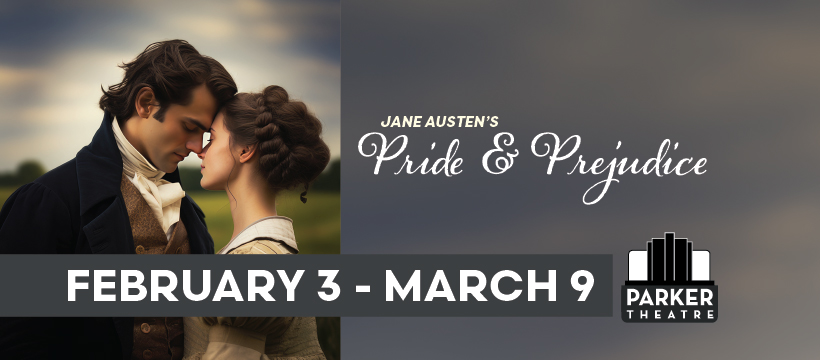SOUTH SALT LAKE – The Parker Theatre is well suited to delivering a solid performance of Jane Austen’s Pride and Prejudice on the stage. Directed by Jennifer Hohl, this stage adaptation of the well-loved 1813 novel is attributed to Jennifer Hohl and Jasmine Jones Hohl. The adaptation uses much of the text and retains the appearance and integrity of the Regency period. The production does well in balancing the many beloved characters, events, and story moments with the runtime – what feels like a breezy two and a half hours, including intermission. There is much in this production to appreciate as it brings the best of Austen’s wit, introspection, and characters to the Parker stage.
As the central romance in the story, Elizabeth Bennet (Maryn Tueller) and Mr. Fitzwilliam Darcy (Spencer Hohl) initially leave poor first impressions on each other. Their pride and prejudice ought to keep any relationship at bay: Mr. Darcy is standoffish and haughty, and Elizabeth Bennet is resolute in her negative assessment of Darcy’s character. Spencer Hohl marvelously portrays the humanity of Mr. Darcy’s character as he grows and changes in response to Elizabeth’s criticism. Fittingly, Tueller portrays well Elizabeth’s growth as she learns to correct the assumptions and judgments she made about Mr. Darcy. Both Spencer Hohl and Tueller work to build this chemistry between the characters that begins in initial tension and develops throughout the story until both arcs reach a satisfying conclusion. There’s a humanity to both performances that feels real, even unsettling, as they must move past their initial interactions to allow the other to change.

There are many relationships in this show between families, lovers, and even enemies, and so it was a great delight to see that Elizabeth Bennet’s relationship with Mr. Bennet (Michael Hohl) is given emphasis. Michael Hohl is a terrifically humorous patriarch, well balanced with Eden Benson as Mrs. Bennet, and the Bennet family was a wonderful ensemble overall, with each sister giving a distinctive performance. I give credit to many members of the cast who portray dual roles throughout the production, filling the stage with the large ensemble of Regency characters.
Many plot elements are revealed in letters or through reciting prior events – primarily to Elizabeth Bennet. The production uses the theatricality of the stage to begin the narrative and then transition to a prerecorded voice-over wherein the actors portray the events as described. Notably, the letter Mr. Darcy writes to Elizabeth following Darcy’s disastrous proposal starts the second Act, relaying the information concerning George Wickham. Similarly, when Mr. Collins explains the charge from Lady Catherine to marry, the audience sees a recreation of this scene. In this choice, the production dramatizes the events for the audience, which greatly aids the flow and variety of the production.
Likewise, the adaptation uses the many dances and balls to break up lengthy dialogue. There is particular attention in dramatizing Elizabeth and Mr. Darcy’s dance and conversation at the Netherfield ball: their conversation begins in dance; then the lights dim and focus on them alone, with the remaining dancers in shadow upstage. It’s one of those moments where lighting, staging, music, and performance come together to create an effective impact on the characters themselves.

Another highlight of the production is the set design by James B. Parker and properties by Danna Barney. Simple, white-walled panels with wall frame molding effectively separate the stage into theatrical spaces and create lovely stage pictures throughout. The fluidity of movement between the many different settings is handled extremely well, adding variety and helping to differentiate sitting rooms, dining rooms, and dance halls. Keeping the walls timeless and flexible allows the set furniture to better distinguish the estates of the characters and settings, especially in establishing the progression of wealth from Longbourn (Bennet’s home) to Netherfield (the Bingley’s estate), and eventually Darcy’s estate at Pemberley.
As I watched the production, I marveled at how well the furniture and set décor worked to establish the setting. I wondered how many individual pieces there were backstage. Especially when the scene changes moved so efficiently throughout the play. Costumes designed by Lauri Baird also befitted the environment of the set and conveyed similar distinctions in wealth from the Bennet’s to Caroline Bingley and Lady Catherine De’Bourgh. The hair pieces were particularly distinct in their appearance, indicative of the wealth of certain individuals.

Filled with a variety of personalities and characters faithful to the text and various popular adaptations, Pride and Prejudice at the Parker Theatre is a delight of a show. It is difficult to highlight all the moments and performances that made this reviewer smile, laugh, and wish to share the hearty enjoyment of this Austen favorite and ever-perennial romance. Much will feel familiar to prior adaptations, and yet the venue and performers find a distinction, a special zing that can only be captured in the thrill of a live performance. The fan of romance – Austen, Regency, or otherwise – will certainly see the lively delights of attending during this Valentine’s season. There is such sincere effort in bringing this adaptation to the stage, and the performances are worthy of “ten thousand pounds a year.”
[box]Pride and Prejudice plays on Fridays and Saturdays at 7:30 PM and Saturdays at 3:30 PM through March 9th at the Parker Theatre (3605 South State Street, South Salt Lake, UT 84115). Tickets are $18-27. For more information, visit parkertheatre.org. [/box]

